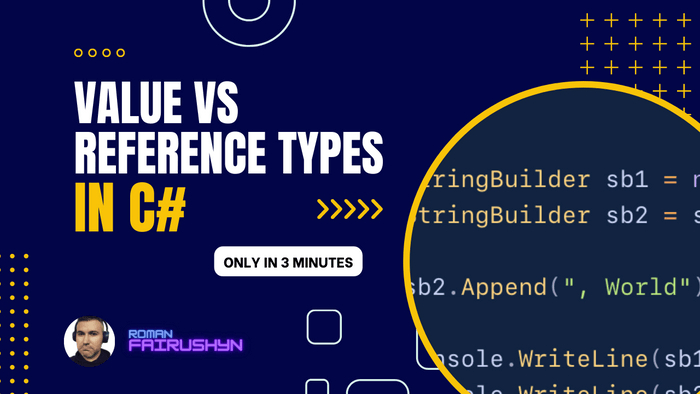Value vs Reference Types In C#
3 min read · — #csharp-interview#junior
In C#, data types are divided into two categories Value Types and Reference Types. Understanding the difference between value types and reference types, and how they behave, is key to being proficient in C#, particularly when dealing with data structures, method parameters, and performance considerations.
Value Types
Value types in C# are stored in the Stack memory. Each value type variable holds its own copy of the data, and it is stored directly. If the data is assigned from one value type variable to another, then the system will create a separate copy of the data. Any changes made to one variable will not affect the other variable.
These are usually simple primitive types that include all numeric data types, Booleans, Characters, DateTime, TimeSpan, and Structs (if they only contain value types).
Value types directly contain their data which means that operations on the data are done directly on the stored values. Since these types are created on the stack, memory allocation and deallocation are more straightforward, leading to potentially more efficient memory usage.
One major feature of value types is that when they are assigned to a new variable or passed as a method parameter, the value is copied. This means that changing the value of one variable does not affect the other.
int a = 10;
int b = a;
b = 20;
Console.WriteLine(a); // Output: 10
Console.WriteLine(b); // Output: 20In this example, changing the value of b did not affect the value of a, even though b was initially set to a's
value.
Reference Types
Reference types in C# are stored in the Heap memory. When creating a reference type variable, the system allocates memory in the heap and then stores the address of the memory location in the variable stored in the stack. When the data is assigned from one reference type variable to another, both variables refer to the same memory location. So if the data is changed using one variable, it also gets changed for the other.
Reference types include Classes, Interfaces, Delegates, and Arrays. These types store references to the actual data, unlike value types which store the actual data. When you assign a reference type to another variable, the address is copied, not the actual data itself. Both variables then point to the same memory location -- changes made through one variable are reflected in the other.
StringBuilder sb1 = new StringBuilder("Hello");
StringBuilder sb2 = sb1;
sb2.Append(", World");
Console.WriteLine(sb1); // Output: Hello, World
Console.WriteLine(sb2); // Output: Hello, WorldIn this example, appending text to sb2 also affected sb1, because both reference the same memory location.
The Key Difference
The key difference between value types and reference types is that value types hold the actual data, while reference types hold a reference to the data's location in memory. This fundamental difference leads to different behavior in the way these types are handled in the code, and it's essential to understand this to avoid unintended side effects.
Whether to use value types or reference types depends on the specific needs of your program. Value types are generally more efficient in terms of memory and performance, but they lack the flexibility and functionality provided by reference types. Conversely, reference types are more flexible and powerful, but they can lead to potential pitfalls if not handled correctly, like unexpected side effects from changing data in one place that another part of your code is also referencing.
References
By understanding these nuances, you can choose the right type for your specific use case and write more efficient and effective code.
